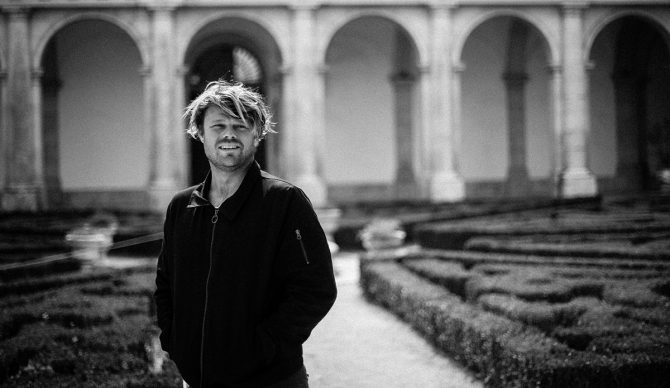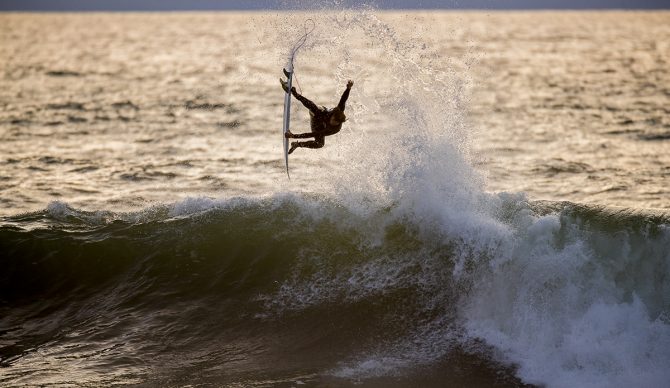
Dane Reynolds has carried the torch for the modern freesurfer for over a decade and has influenced nearly every CT star with his raw surfing and production chops. But Reynolds’ very relatable (sometimes paralyzing) self-doubt continues to push him in new directions. Photo: Grant Ellis
The wind blows sand on both of us as Dane Reynolds nervously picks through his lunch, leaning against a chainlink fence near Makaha Beach one morning on the West Side. I’d cornered him at a Vans event he was attending for his sponsor as Sustainable Coastlines Hawaii broke down the very real ocean plastics problem for the media. In one segment, Dane was fully participating, answering questions in a pros-on-pros contest to see if some of surfing’s best knew anything about plastics. “They come from fossil fuels,” answered Dane to one question on where plastic comes from. He scored points. He seemed comfortable.
Now, he doesn’t seem so at ease. He sweats a little (it is Hawaii, even in the winter), and his hands shake slightly as he picks through his fried rice laid out in a styrofoam box. I kind of feel like a dickhead for pinning him down to talk.
I’ve wanted to interview him for a while now. We’ve spoken before, and I’ve respected the guy from afar since. Especially the way he surfs – like a lot of us want to. To me, Dane surfs to get rid of an angst he doesn’t know what to do with. His art, I suppose, thrown out on a piece of ocean, using his rail to lasso every frustration he’s had in his life – the way that piece of foam cuts through the water under his feet with such fierce fluidity, liquid spraying away with his emotions. There’s something he’s getting out of his body when he’s in rides waves.
I can’t think of one young surfer I’ve talked to that hasn’t been influenced by him: from Caity Simmers to Eli Hanneman. Even John John has a little of that special angst in his downcarve that seems like a not-too-distant cousin of a Dane Reynolds turn. Yet here he is wearing long, well-worn denim shorts, a white short-sleeved collared shirt (untucked), white socks, Vans shoes, hinting in an interview that he might not be as relevant anymore.
“I just got to Hawaii, and I feel like a fossil,” he says. “I just need to do like a de-fossilization trip and just go surf all day somewhere.”

Tail high still seems pretty en vogue. Photo: Grant Ellis
We’re in Hawaii for the revamped Pipe Masters. A contest that in his younger years, he was always – always – a threat to take out. The wind-strewn patch of ocean he’d grown up surfing in Ventura had served him well in being able to manifest scores where others couldn’t, simply by the power and creativity of his turns. And his natural sense in finding the inside of a tube. But his nerves betrayed him in contests – his performance anxiety a very real thing.
“I swore that I’ll never do it again,” he said of surfing competitively. “I don’t know if it’s like PTSD from how much pressure I put on myself or what, but it just doesn’t feel right. And I don’t like it, and didn’t want to do it.” I reminded him we’d talked about it before.
“Last time I (competed) was for the Stab contest, which is the coolest format ever. And I just hated the pressure and did terrible and just didn’t enjoy it. The last couple years, every time I’m like, ‘Okay, I’ll do it.’ And then I do it. And I just don’t enjoy the experience. And I don’t like the pressure. And I don’t have to do it.”
So he doesn’t. And that works. Dane made a movie about this anxiety, Chapter 11 – which also turned out to be his opus to a surf industry he felt was sucking the life out of him at the time. He couldn’t take the corporatized version of riding waves in that phase of his life. Even the title signified the end of a road.
The Inertia published several reviews of Chapter 11. Some positive. One kinda scorched-earth negative, which understandably didn’t sit well with him and caused quite the internet stir. I remind him of that, and tell him I didn’t necessarily agree with the review. He doesn’t remember it at first. Or says he doesn’t. But it comes up later.

Frontside airs? With a grab? Never not relevant. Photo: Grant Ellis
Dane is as busy as anyone in the surfing world right now. He has three young kids. He’s running his website, aptly named Chapter 11, running his brand, Former, and on top of all that, just opened a Chapter 11 storefront in his hometown. Dane Reynolds is a businessman now. He’s all in. And he seems thankful that business is better.
It’s no secret that running Former has been a struggle for him and his partners. He hints that the brand was on the edge of folding, which would have been sad given all that he’s put into it. Maybe he underestimated brand awareness, or how far his name could take him, or even the oversaturated surf apparel market. Whatever it was, things didn’t go well for years. But then, according to Reynolds, a distribution partnership in Australia saved Former’s bacon. “I have so much respect for business owners now,” he said. “You kind of have to, for brand recognition, tough it out for five years. I see what John John is doing with Florence Marine X and Julian Wilson, and I’m like, ‘I wish they would have talked to me first.’”
That five-year mark was crucial, he says. “We were able to just tough it out with no growth, and now it’s starting to turn around. There’s this feeling like things are coming together. Former wasn’t available in Australia for the first four-and-a-half years. And then as soon as we linked up with an Australian distributor who has been killing it, and it’s like, I don’t know, it saved us. And Craig (Anderson) is still such a big part of who we are and surf culture in Australia. It’s done wonders for our business down there. It feels good that we’re clearly turning a corner but it was a big learning curve. Because in my mind when we started, it was like me, Craig, Austyn Gillette and Dylan Rieder. I was like ‘They’re influential skaters, (a collection) like this hasn’t happened before. How could we fail?’ And then it’s just a real big learning curve on spending money and selling enough product. I have a massive newfound respect for the surfing industry. It makes me feel childish with (Chapter 11) that you guys poorly reviewed. But that was my absolute truth at that moment. And I’m so proud that I did it. But in hindsight, I was very naive. After running a business for five years, it’s tough.”
For all of his reluctance to surf contests, he’s never been afraid to put himself out there in the artistic sense. Filmmaking, his freesurfing, his shaping, his heart and soul into a brand. Even with the toxicity of the internet and all the soulless, anonymous trolls waiting to pounce. I ask him why that never scares him.
“For some reason, I’m compelled to (put myself out there),” he says. “I don’t know why exactly. But I guess it’s like, kind of happened with Chapter 11. When I started having panic attacks from the pressure of professional surfing, when I started seeing a therapist who has worked with other surfers, he was just like, ‘You have no idea how many guys have this.’ And I’m like, ‘What? How did I never know?’ Why does nobody talk about this? And it comes back to like, I see a lot of people that think, looking at it on paper, professional surfing is the ideal lifestyle. But like with celebrity, everybody thinks that having money solves all your problems, or fame, or whatever. And I guess I was just compelled to show that it doesn’t protect you from being human. That is where my head was at (with Chapter 11). And I wanted to tell the story at that moment. And other stuff. I just like storytelling, I guess.”
Dane’s platform has changed these days. His videos come live and direct through the new website instead of Marine Layer. They still feature his surfing – as compelling as ever – but he’s eased in other Ventura County regulars – characters that maybe never had a way to get their surfing out to the general public. Like Mickey Clarke, Jake Kelley, and Eithan Osborne – whose surfing has absolutely become more visible because of his association with Dane.

Dane Reynolds is surely in a more reflective state these days. Photo: Grant Ellis
“I’ve had this thing over the years, where I’ve been surfing with kids, and they bug me,” he tells me. “And then they end up being like 17 or 18 and I finally talk to them. And they’re super cool. And I’m like, ‘What an asshole I am.’ Anyways, it’s kind of like that with a Tom and Micky Clarke. They turned out to be super cool kids that I wanted to hang with and surf with all the time. And they were getting me psyched to surf. I was genuinely curious about how they were putting out stuff these days, because things have changed so much since Marine Layer, where you could stick something on Vimeo and get 100,000 views in a day. Kids generally don’t know where to put stuff out. And I’m surfing with them every day. I still enjoy filming and surfing as much as I can. And these kids are getting stoked and are kind of lost with their deal. They’re like, ‘should we do a website or make a platform?’ I feel like it’s a bit grindy to be 36 and still trying to film clips and do errands and stuff. But I love it and enjoy it. And I like surfing with these kids. So it’s kind of a win-win that I’ve created a platform that I believe is giving them sort of relevance and a place in surfing and a way of getting stuff out. And it’s a way for me to still be a part of it.”
The Chapter 11 YouTube channel features a bloom of fresh cuts from his film conglomerate, with Dane at the forefront of production. He’s got an upcoming film project with Billabong, which he tells me he’ll produce, his freesurfing continues to be must-watch internet television. And every young, hard-charging grom you know still puts every Dane Reynolds video they can find on playback before they head out into the ocean. As we sit there, sweating in the sand together, I can’t help but wonder: is there really anything more relevant?

